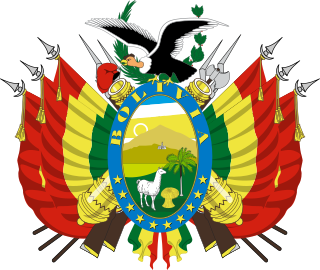
The coat of arms of Bolivia has a central cartouche surrounded by Bolivian flags, cannons, laurel branches, and has an Andean condor on top.

The coat of arms of Chile dates from 1834 and was designed by the English artist Charles Wood Taylor (1792–1856). It is made up by a figurative background divided in two equal parts: the top one is blue and the bottom, red. A five pointed white star is in the centre of the shield. This background is supported in one side by an Andean condor, the most significant bird of prey from the Andes, and in the other, by a huemul, a mammal endemic to Chile. Both animals wear golden naval crowns symbolising the heroic deeds of the Chilean Navy in the Pacific Ocean.
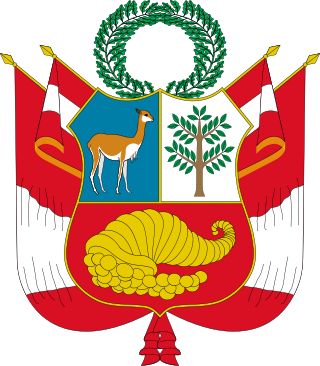
The coat of arms of Peru is the national symbolic emblem of Peru. Four variants are used: the coat of arms per se, the National Coat of Arms, the Great Seal of the State, and the Naval Coat of Arms.

The coat of arms of Antioquia, in its current form, dates back to August 23, 1812, when it was officially adopted by the Chamber of the Senate of Antioquia by means of Decree 21 of 1812, replacing the Great State Seal of Antioquia that was sanctioned by State President José María Montoya Duque on September 2, 1811. Following the incorporation of Antioquia to the United Provinces of New Granada and subsequently to the Granadine Confederation and the United States of Colombia, the Sovereign State of Antioquia adopted the coat of arms of Colombia as its state arms. Antioquia reverted to the original coat of arms in 1912 for the occasion of the centenary of the independence of Antioquia and it has been in official use ever since.

The national flag of Mexico is a vertical tricolor of green, white, and red with the national coat of arms charged in the center of the white stripe. While the meaning of the colors has changed over time, these three colors were adopted by Mexico following independence from Spain during the country's War of Independence, and subsequent First Mexican Empire.
Most Mexican states do not have an official flag. For these states, a de facto flag is used for civil and state purposes. State flags of Mexico have a 4:7 ratio and typically consist of a white background charged with the state's coat of arms.
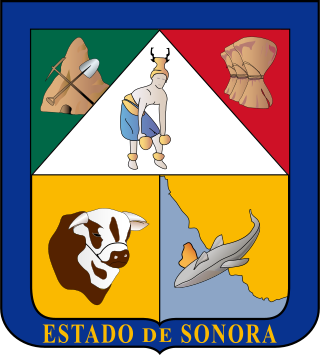
The coat of arms of the Mexican state of Sonora, has a shield with a blue outline and a golden inscription on the bottom part which reads "Estado de Sonora" ("State of Sonora"). The internal section of the shield of Sonora is divided in two:

The Coat of arms of Aguascalientes is a symbol of the Free and Sovereign State of Aguascalientes in Mexico. Was adopted in 9 June 1946.
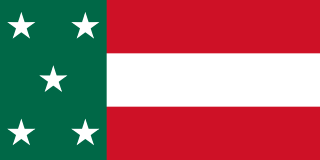
The flag of Yucatán is the flag used by the former Republic of Yucatán, when in the middle of 19th century it was proclaimed in the territory of the Yucatán Peninsula. The republic comprised the present Mexican states of Yucatán, Campeche and Quintana Roo.

The coat of arms of Gran Colombia was adopted in 1821.
The flag of Chihuahua City, Mexico was adopted as a symbol of the city on 2007.

The coat of arms of Jalisco is a symbol of the Free and Sovereign State of Jalisco in Mexico.

The coat of arms of Yucatán is a symbol of the Free and Sovereign State of Yucatán.

The coat of arms of Tlaxcala, a federal entity located in central highlands of Mexico, is a representative symbol that encapsulates the rich history and cultural identity of this region. Designed with meticulous attention to detail, this heraldic emblem reflects both the pre-Hispanic heritage and the colonial influence that have marked Tlaxcala's trajectory throughout the centuries. Its visual composition combines emblematic elements that evoke indigenous tradition, such as the emblematic Maltese cross, with symbols of the Catholic faith and references to native flora and fauna. Through its symbolism, the coat of arms of Tlaxcala draws a bridge between the past and the present, serving as an emblem of identity and pride for the inhabitants of this Mexican state.

The coat of arms of Querétaro is a symbol of the Free and Sovereign State of Querétaro in Mexico.

The Coat of arms of Puebla is a symbol of the Free and Sovereign State of Puebla.

The Coat of arms of Sinaloa is a symbol of the Free and Sovereign State of Sinaloa. It was created by the painter and scholar of Yucatecan heraldry Rolando Arjona Amabilis, was adopted in 1958.

The Coat of arms of Tamaulipas is a symbol of the Free and Sovereign State of Tamaulipas.
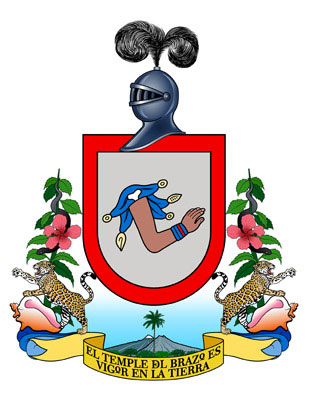
The Coat of arms of Colima is a symbol of the Free and Sovereign State of Colima. It was adopted on 13 August 2016.



















